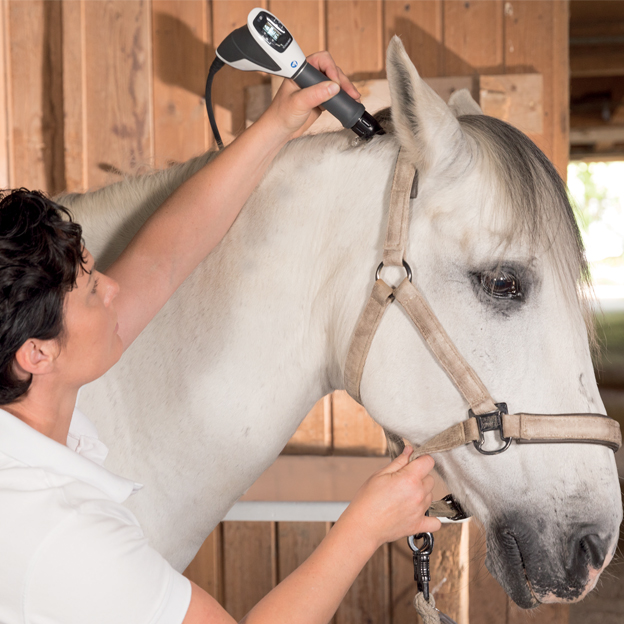Equine Therapy: Just How It Assists Build Confidence and Emotional Toughness
How Laser Treatment in Equine Treatment Is Revolutionizing Veterinary Take Care Of Steeds
Laser treatment has arised as a transformative method in equine vet care, giving a non-invasive service that speeds up healing and boosts general wellness. The portability and convenience of laser therapy devices further underscore their expanding indispensability among veterinarians.
Recognizing Laser Therapy

The innovation behind laser treatment is grounded in the principle of photochemistry, where photons are absorbed by chromophores within cells, bring about enhanced ATP production and modulation of responsive oxygen varieties (Equine Therapy). This, consequently, promotes cellular expansion, minimizes swelling, and accelerates recovery. Vet practitioners make use of various kinds of lasers, consisting of low-level lasers (LLLT) and high-power Course IV lasers, relying on the certain therapeutic goals and the nature of the equine condition being treated
Different laser wavelengths and power setups are carefully chosen to target different cells depths and attain desired clinical end results. Safety methods are vital, as improper usage can lead to thermal damage or suboptimal healing results. Thus, a detailed understanding of laser therapy's systems and applications is crucial for its efficient application in equine vet practice.
Advantages for Horse Wellness
The myriad advantages of laser treatment for equine health and wellness include enhanced recovery, pain decrease, and improved movement. This advanced treatment technique leverages certain wavelengths of light to penetrate cells, stimulating cellular feature and advertising quick tissue repair service. The non-invasive nature of laser therapy guarantees marginal tension and discomfort for the steed, assisting in a smoother recuperation procedure.
Boosted recovery is among the primary benefits, as laser therapy increases mobile regeneration and collagen synthesis. This results in faster recuperation times from injuries and surgeries. Pain decrease is attained via the anti-inflammatory effects of laser therapy, which decreases swelling and decreases the manufacturing of pain-inducing chemicals. Consequently, equines experience considerable remedy for chronic and intense pain problems.
Enhanced flexibility is another crucial advantage, particularly for efficiency and working steeds. By minimizing swelling and discomfort, and boosting cells repair, laser therapy assists in bring back joint feature and muscular tissue adaptability. The advancing result of these benefits is not only a quicker go back to regular task but additionally a general enhancement in the equine's lifestyle. Therefore, laser treatment stands as a transformative device in contemporary equine veterinary treatment.
Usual Conditions Dealt With
Laser therapy has actually arised as a functional therapy alternative for a variety of common equine conditions. Among these, bone and joint injuries are especially responsive to laser therapy. Equine Therapy. Soft tissue injuries, such as tendonitis and tendon pressures, take advantage of the anti-inflammatory and analgesic impacts of laser therapies, which speed up recovery and minimize pain. Additionally, laser therapy is effective for problems like osteo arthritis, where it helps mitigate joint swelling and advertise cells repair work.
Wound monitoring is an additional area where laser treatment has actually shown substantial guarantee. Persistent wounds or slow-healing abscess can page be specifically challenging in equines, yet laser therapy improves cellular regrowth and boosts blood flow, thus expediting the healing procedure. Moreover, laser therapies have actually been effectively utilized in managing hoof problems such as laminitis and abscesses, minimizing discomfort and advertising faster recovery.

Modern Technology Behind Laser Therapy
Past the myriad problems treatable with laser therapy, the technology itself merits closer evaluation. At the heart of laser therapy is making use of details wavelengths of light to penetrate cells and generate organic reactions. These wavelengths, typically ranging from 600 to 1000 nanometers, are uniquely taken in by chromophores in the skin, muscle, and other tissues, prompting a cascade of cellular occasions.
Laser gadgets used in veterinary medication commonly use low-level laser treatment (LLLT) or cold laser treatment. Unlike high-powered click over here medical lasers, these gadgets run at lower energy degrees, optimizing healing benefits while minimizing thermal damage. The energy from the laser light promotes adenosine triphosphate (ATP) production, improves mobile metabolism, and speeds up tissue fixing procedures.

Success Stories and Study

Showcasing the concrete benefits of laser therapy, countless success stories and study brighten its transformative effect on equine health and wellness. One such situation entails a pure-blooded racehorse suffering from persistent tendonitis. Conventional treatments yielded marginal improvement, yet after incorporating laser treatment right into the regimen, the steed showed significant decreases in inflammation and pain within weeks, eventually going back to affordable racing.
Another engaging instance includes a dressage horse detected with severe pain in the back, limiting its efficiency. A veterinary group used low-level laser treatment (LLLT) to target the inflamed areas, causing marked renovation in adaptability and a significant decline in pain. Over a number of sessions, the equine regained its peak form, showcasing the efficacy of laser treatment in addressing musculoskeletal problems.
Furthermore, a study carried out at a leading equine facility analyzed 50 horses with various soft tissue injuries treated with laser therapy. The outcomes were striking: 85% of the steeds showed sped up recovery times and enhanced movement. These situations underscore the flexibility and efficiency of laser treatment in equine medicine, supplying a non-invasive, scientifically-backed strategy to improving recovery and efficiency in equines.
Conclusion
Laser treatment is revolutionizing equine veterinary care by giving a non-invasive treatment that speeds up recovery, decreases inflammation, and eases discomfort. With its efficiency in treating a variety of conditions, from bone and joint injuries to chronic ailments like osteoarthritis, this innovation substantially boosts equine health and wheelchair. The transportability and adaptability of laser therapy further underscore its transformative influence on vet techniques, solidifying its function as an essential device in modern equine health care.